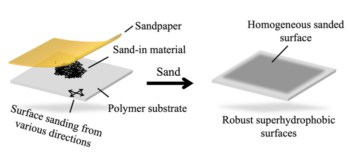
Air conditioning accounts for 10% of global energy consumption. Now researchers at Columbia University and Argonne National Laboratory in the US have produced a polymer “paint” capable of cooling surfaces to around 6 °C below ambient temperatures without using any energy at all. Used in combination with conventional air conditioning, it could allow significant reductions in the time these units are switched on, as well as providing some cooling relief in areas where air conditioning is not so widely available.
The approach uses a solution process at room temperature to produce a film of a polymer with nanometre- and micrometre-sized air voids trapped inside. “There are a lot of examples of substances that are white from air voids – like snow for example,” says Nanfang Yu associate professor in Applied Physics at Columbia University in the US. “Snow is white because there are a lot of air bubbles inside, otherwise you have ice which is transparent – it’s as simple as that. We are just pushing this to the extreme by this chemical process.”
The solution process they use is based on “phase inversion” and involves mixing the polymer with a solvent alongside water, in which the polymer is insoluble. After painting the mixture onto a surface, the solvent evaporates leaving just the polymer interspersed with water droplets. Finally the water evaporates leaving air voids.
Adjusting the percentage of water in the mix allows precise control over the size and density of the air voids, so that they can be tuned to maximize reflection of solar energy. In addition the micrometre-sized voids give the coating a thermal emissivity close to that of a black body, that is, a perfect radiator of heat. This high thermal emissivity of the polymer coating can be used to cool objects that are already hot.
Yuan Yang, an assistant professor in materials science and engineering at Columbia University describes how he came across the phase-inversion-based chemical process through another strand of his research, which focuses on energy storage. “This method has been known for very many years. Battery people use it to make something called a separator, and as I knew that film is also white I thought why don’t we try this.”
Clear and stable
It is widely known in photonics that structures with a dimension similar to the wavelength of incident light will scatter it strongly, and the Columbia University and Argonne National Laboratory researchers are far from the first to try to exploit this to increase the reflectivity of a coating. However previous work has largely focused on using nanoparticles of high refractive index, TiO2, for example. Although TiO2 nanoparticles are used for white paint, they can be expensive, difficult to disperse evenly and they absorb UV light very strongly, Yu tells Physics World. Using air voids instead provides a “very elegant solution” and is the first time a cooling coating can be applied as paint in this way.
“It’s important that we chose this particular polymer P(Vdf-HFP) because it has essentially zero absorption across the solar spectrum, which includes UV, visible, and infrared components,” says Yu. “So if you start with this polymer and include air voids, the film doesn’t absorb sunlight and backscatters it strongly.”
Another key attribute of the polymer is its stability. Yang points out that while some other polymers may also work, they may degrade in time. “For example if you take cellulose, the main component of paper, it is white but we know it will become yellow over time.” He adds that the researchers have tested porous P(Vdf-HFP) films extensively and observed no change over a month in the field. “There may be other polymers as well – for instance, PMMA may also work or may not. We have tried one but there are more to explore.”

Getting to business with coatings
Commercial interest
Although the polymer coating performs best when it is white, optimizing the reflectivity, the researchers were also able to demonstrate benefits of the paint when dyed yellow and blue with pigments. With no discernible compromise in colour to the naked eye, the coloured coatings can remain 10 degrees cooler than commercial counterparts in the same conditions because they reflect much more sunlight in the near infrared part of the spectrum. Incorporating colours makes the coatings even more attractive as a paint. Companies have already approached the researchers expressing an interest in commercializing the paint, and they are looking into the necessary tests for standardization.
Full details are reported in Science.



